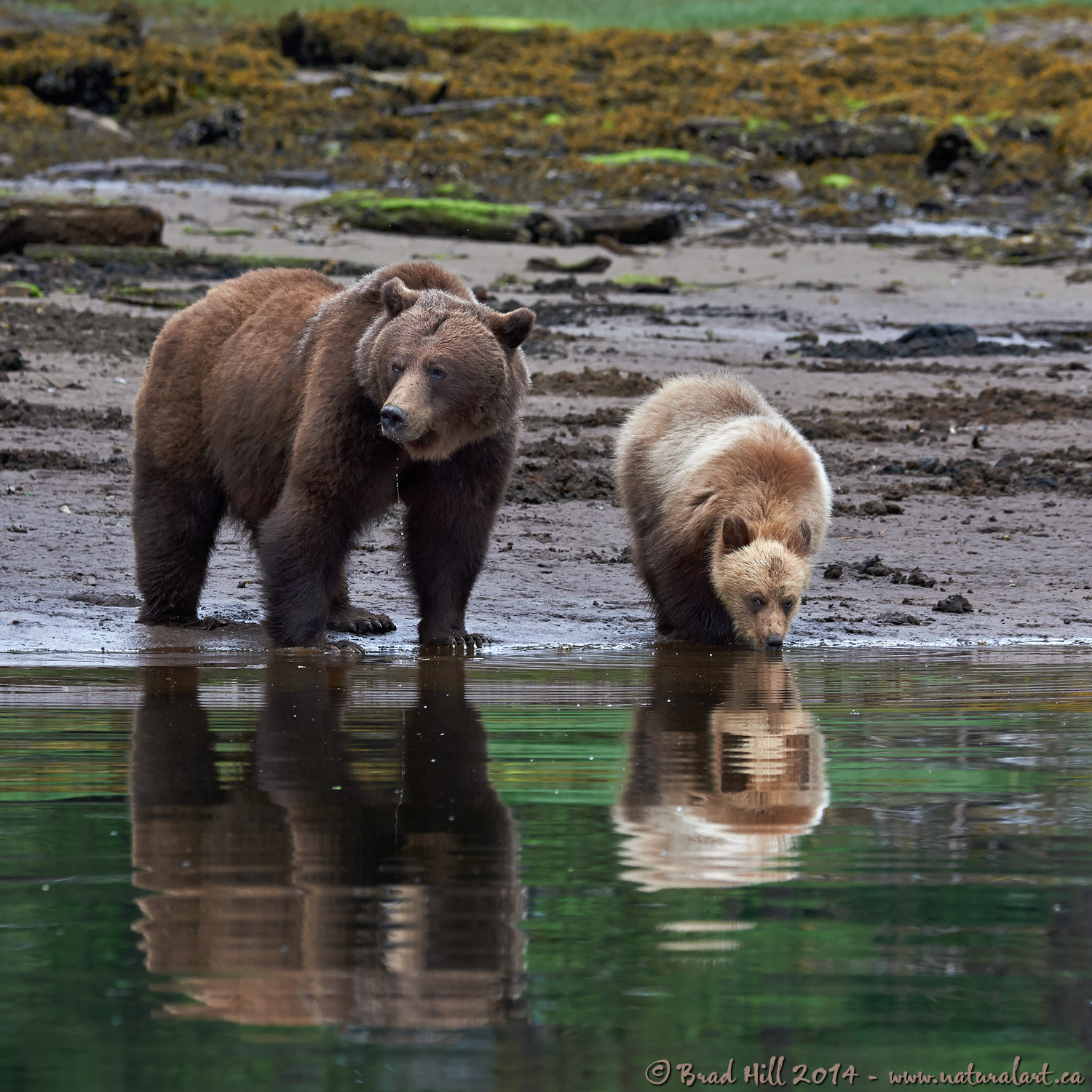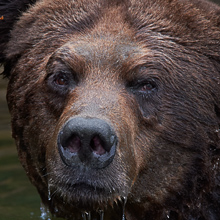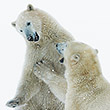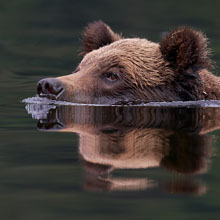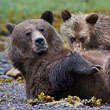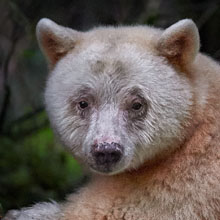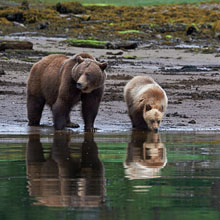Availability: Undetermined - Enquiries?
In the Field
On the Lookout. Khutzeymateen Grizzly Sanctuary, northern BC coast, Canada. May 29, 2014.
The more time I spend watching and photographing bears, the more I come to appreciate the special bond between a female bear and its dependent young. The complexity of the mother bear-cub relationship rivals that of a human mother and its child (and, trust me, I'm still trying to figure that one out!). One of the aspects of the relationship between a female bear and her cub that is virtually always on display is her almost fanatical protectiveness - even when you think Ma is relaxing and doing something else, she's ALWAYS keeping an eye out for danger that may threaten her cub. And that's what I like about this shot (tho' I have to admit I don't mind the dual reflections and the water trickling down from Ma's chin either). Just prior to this shot Ma had to coerce her cub to come down to the shoreline to drink and watched it all the way down. Once on the beach Ma refused to drink for nearly as long as the cub did and - as shown here - spent a lot of time looking out for danger. What's not obvious here is why Ma is looking to her right - at the time a slight breeze was blowing from the right of the frame, which meant she had that area "covered" with her sense of smell (and knew that the coast was clear in that direction). And, this female pretty much ignores humans when they're behaving themselves offshore in a boat and felt no threat from us. About the only thing she didn't know was what was up the beach (and around the corner) in the direction outside the left side of the image frame. And, that's exactly where this Good Mom kept looking...fully on the lookout while sneaking a drink herself!
Moving to the photographic side of things...I have to say that my taste is normally away from square crops or square presentations of images (I normally prefer the more dynamic 3:2 aspect ratio that most DSLR's natively capture). Yet when I saw this scene setting up I instantly thought that the space occupied by the bears and their reflections - combined with the directions the bears were likely to be looking - would be likely to dictate a square crop. What I wasn't totally sure of at the time of capture was exactly how much foreground and background I wanted to include in the image. And, I knew I didn't care to have a whole lot of space on either side of this image. So, I captured this image vertically - giving me some room to crop a little top and bottom to suit my taste. So what you're looking at here is full-frame horizontally with the bulk of the crop coming off the bottom of the image. Given this image was shot with a Nikon D4, this leaves the cropped full-resolution image at 3280 x 3280 pixels. While this somewhat reduces the options (and possibly the economical value) of the image, in real terms it's still plenty big enough (pixel-wise) for many - if not most - commercial uses...
One final comment: "Conventional" compositional guidelines suggest that your subject should almost always be directed into - or looking into - the frame, rather than out of it (i.e., more room in front of the subject than behind it if the subject is looking in any direction other than straight at you). So...what happens when - like in this case - your subject is pointed ONE way, but looking the OTHER way? Where should you position the subject in the frame? Well, in my opinion, it starts becoming a bit of a crap-shoot. In this case because BOTH bears were angled slightly to the right side of the frame and only ONE was looking to the left side of the frame, I chose to give dominance to the right side of the frame and let protective mom look OUT of the frame (to the left). And, in this case, I happen to LIKE that mom is checking outside the frame and thus leaving the viewer wondering what the heck she is looking at! I know some will agree with this decision and others won't but...hey...this kind of thing is totally subjective and compositional guidelines are just that - guidelines! And, at the end of the day, it's MY decision and MY image! Plus it's good food for thought. ;-)
Some might be interested in the image quality of the lens used here (the AF-S 80-400mm f4.5-5.6 VR @ 200mm - so for those interested here's a higher resolution (2400 pixel) image for your scrutiny:
• On the Lookout: Download 2400 pixel image (JPEG: 2.5 MB)
NOTE 1: This image - in all resolutions - is protected by copyright. I'm fine with personal uses of it (including use as desktop backgrounds or screensavers on your own computer), but unauthorized commercial use of the image is prohibited by law. Thanks in advance for respecting my copyright!
NOTE 2: Like all wildlife images on this website, the subject is fully wild and completely unconstrained. Besides the potential impact of my presence, nothing has been done to intentionally alter or affect the ongoing behavior of the subject and, of course, there has been no use of any form of bait or other form of wildlife attractants (including vocalizations).
NOTE 3: This image was captured during one of my "Grizzlies of the Khutzeymateen" photo tour in the spring of 2014. Each year I offer trips into two different parts of the Great Bear Rainforest as well as one to photograph aquatic mammals and oceanscapes near the northern tip of Vancouver Island. And, in selected years, I also offer photo tours to locations to capture other highly sought-after subjects, such as various boreal owl species and wildlife of Canada's Arctic. Details about these trips can be found on the Photo Tours page of this website.
Behind the Camera
On the Lookout. Khutzeymateen Grizzly Sanctuary, northern BC coast, Canada. May 29, 2014.
Digital Capture; Compressed RAW (NEF) 14-bit format; ISO 1000.
Nikon D4 paired with Nikkor AF-S 80-400mm f4.5-5.6 VR @ 200mm - hand-held from floating Zodiac. VR on in Active mode.
1/500s @ f7.1; no compensation from "recommended" matrix-metered exposure setting.
At the Computer
On the Lookout. Khutzeymateen Grizzly Sanctuary, northern BC coast, Canada. May 29, 2014.
RAW Conversion to 16-bit TIFF, including first-pass/capture sharpening using Phase One's Capture One Pro. Three raw variants (different versions of a single raw capture) processed, differing by a total of 0.5 stops in exposure.
Further digital corrections on resulting 16-bit TIFF files using Adobe's Photoshop CC and Light Crafts LightZone. Photoshop adjustments included compositing (blending) of the three output files from the raw converter, further slight exposure adjustments/tweaks, selective desaturation of colors, and selective sharpening for web output. Final tweaking of tones performed using LightZone's "tonemapper" tool.
Conservation
Hasta la Vista, Baby! Khutzeymateen Inlet, BC. June 5, 2006.
Ten percent of the revenue generated by this image will be donated to Raincoast*.
Species Status in Canada**: Special Concern (May 2002).
While Grizzly Bears (Ursus arctos) are not technically listed as "Endangered" in Canada, they have been extirpated from most of their historical range. Grizzly Bears are far more sensitive to intrusion/disturbance in their habitat than are Black Bears and are being increasingly forced into marginal habitat by human encroachment. The Great Bear Rainforest along the central and northern coast of British Columbia is one of the last strongholds of the Grizzly Bear in Canada, and even this population is coming under increasing pressure.
On December 18, 2017 the government of British Columbia banned grizzly hunting across the entire province. This major conservation victory came after decades of tireless work by many dedicated conservationists and ecologists and, most importantly, it reflects the opinion of the vast majority of British Columbians. And, it means that AT LEAST while the current government remains in power grizzlies are finally "safe" in British Columbia.
Now that we've at least temporarily won the battle to save grizzlies in BC, it's time to re-focus our efforts toward protecting ALL of BC's carnivores, including Gray Wolves, Black Bears, Cougars, Wolverines, and more! Simply put, there are no ecological, economic, or ethical arguments supporting the trophy hunting of carnivores.
In a great first step towards ending the hunting of carnivores throughout BC the Raincoast Conservation Foundation has developed a program designed to protect ALL carnivores within the Great Bear Rainforest. Details about this program can be found on this page on Raincoast's website. Check it out and, better yet, make a donation to help Raincoast purchase the remaining commercial hunting tenures in the Great Bear!
*The Raincoast Conservation Society (and Foundation) is an effective and efficient organization that has been fighting for protection of this unique habitat. If you are looking for a meaningful way to contribute to the conservation of this amazing ecosystem, Raincoast will provide maximal "bang" for your conservation dollars.
**as determined by COSEWIC: The Committee on the Status of Endangered Wildlife in Canada












